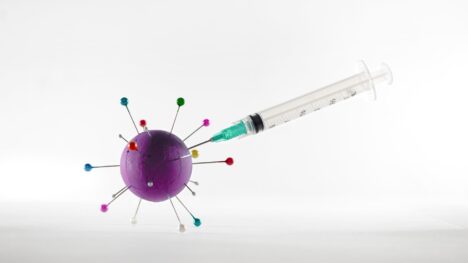When Ian Frazer came from Scotland on a three-month working holiday to Australia, he never dreamed that the trip would change his life as well as the lives of millions of women around the world. For the past 20 years, he has been a man on a passionate mission, and his hard work and perseverance has paid off with the development of the world’s first vaccine to combat cervical cancer. About 500,000 women develop cervical cancer every year and half of those women die from the disease, mostly in the developing world.
Human papillomavirus (HPV), which causes cervical cancer, is the second biggest cause of cancer mortality worldwide. In Australia, about 1000 new cases are diagnosed annually and claim the lives of more than 300 Australian women each year. The new vaccine has the potential to virtually eradicate cervical cancer within a generation and will thus revolutionise women’s health across the globe, saving hundreds of thousands of lives every year.
Yours has been a fascinating journey. Tell us a little about where it all starts.
I was the eldest of three children and as such, had a few responsibilities. Although my father was a doctor, previous generations had been farmers, labourers and miners, so there was a strong feeling that we children were part of the team and we were expected to do our share of the work. But for the most part we were allowed to get on with life as kids. In those days in Scotland, at least in the part where I lived, it was a relatively safe environment, and kids were allowed to get on with things that they wanted to do, and go ahead and explore.
So when you decided to study medicine, did you have an interest in research or did this develop later?
Yes, I was always focused on the research. My father was a doctor and my mother was a scientist before she married my father. I had gone to university originally to study physics, but I decided there wasn’t much of a career prospect as a physicist! Medicine was a means to studying science and it was also interesting. Once I became more involved I decided I enjoyed the business of being a doctor as well—doing good things for individual patients. At least for the first few years after I graduated I concentrated on being a good doctor. What’s happened since then, of course, is that there has been a gradual drift away from clinical medicine toward research.
You have said that the Australian of the Year award was an unexpected honour. How has it changed your life?
Well, first it has taken me out of my research for a year. I think that’s what was to be expected. It is a job for a year. It will make it harder for me to get back into research after that, and get back up to speed again. But what it has done practically of course is that it’s given me the opportunity to promote research. So that’s a very positive outcome.
I am told that you never go back to being yourself again after it, and that’s advice from the previous two Australians of the Year. Perhaps I’m a more of a public speaker now than I was a year ago, because I’ve had a whole lot of it to do this year. But basically I believe that if I am still passionate about what I do, I’ll get on with doing good in every way I can, and the job of being Australian of the Year is just that.
The New Cervical Cancer Vaccine
- The vaccine for cervical cancer known as GardsilTM and CervarixTM became available in Australia in August this year. It will be available throughout the devloped world by the end of 2006
- The vaccine consists of the outer shell or coat of the virus (without the infections material) which stimulates the body’s immune system to fight and kill real viruses obtained through infection.
- The vaccine should be able to prevent 70% of cervical cancers worldwide and save around 200,000 lives every year
- The vaccine will prevent new infection; it cannot help women who are already infected.
- A new vaccine to treat existing infections is currently under development by Professor Frazer’s team at the Centre for Immunology and Cancer Research, Brisbane.
- Data shows that the 9-12 year age-range is the best time frame for inducing optimal immunological protection
- The vaccine protects against 4 types of HPV-6, 11, 16 and 18, which are responsible for approximately 70% of cervical cancers and 90% of gential warts.
Do you still see patients?
No, I stopped practising clinical medicine about five years ago. I kept up with my duties as a physician within the Princess Alexandra Hospital in Brisbane and also running the diagnostic immunology laboratory.
But the time came when it became clear I had to make a decision about what things were going to go, and I decided they had plenty of competent physicians and technology, and they could do without me!
So how did you become interested in human papillomavirus and cervical cancer?
That is a long, complicated story. The bottom line is as usual—scientific observation and looking at the literature. There was evidence that wart viruses may be involved with cervical cancer. It was very new at that time. So I became interested in how these viruses could cause cancer.
How will the new vaccine benefit women worldwide, especially in the developing world? What numbers of women are we talking about?
Well, in the developing world cervical cancer is a big problem—the most common cancer among women, responsible for about a quarter of a million deaths each year. The vaccine, once it’s out there—and that’s the challenge, getting it out there—will be able to prevent a quarter of those deaths. In the developed world the problem is somewhat different because there are screening programs for cervical cancer, but adding the vaccine on top is like an insurance policy.
So, apart from working in the area of science–medicine, is there something else you could see yourself doing?
Well, it would have to be something I felt strongly about; something I enjoyed doing. I would probably end up as an analytical writer. I know I have said I would have liked to be a ski instructor but I think it might get a bit tiresome. Some hobbies are best left as hobbies!
Variety is important also. Being involved in a couple of small biotech companies is interesting from another perspective—in that you get to see how the business side of things works. But I think my major interest in these is that I am involved in products that may be of benefit to patients.
Cervical Cancer Fact Sheet
- Cervical Cancer is the second most commonn cancer in the women worldwide after breast cancer.
- Cervical Cancer is the 13th most common cancer in women in Australia
- About 1000 women are diagnosed with Cervical Cancer each year in Australia
- More than 300 women die of Cervical Cancer each year in Australia.
- One in 193 Australian women will develop Cervical Cancer before the age of 75
- 99.7% of Cervical Cancer are caused by infection with certain strains of human papilomavirus (HPV)
- Human papilomavirus (HPV) are a group of more than 100 viruses
- Certain types may cause warts, or papilomas, which are benign (non-cancerous tumours).
- HPVs which cause common warts which grow on hands and feet are different to those that cause Cervical Cancer.
- Cervical Cancer prognosis is good for early-stage diagnosis
- More than 30 types of HPV can be passes from one person to another through sexual intercouse, including skin-to-skin contact in the genital area. Of these, about 14 are high-risk types that may lead to cancer.
- Many people who have HPV may not show any signs or symptoms. This means that they can pass on the virus to others and not know it.
- Up to 90% of Cervical Cancer are preventable for women who have a Pap test every two years.
- All women who have ever been sexually active should start having Pap tests between the ages of 18 to 70 years, or one or two years after their first sexual intercourse, which ever is later. In some cases it may be appropriate to beging screening before 18 years of age.
- Symptoms appear only in later stages of Cervical Cancer, so regular screening and early diagnosis is imporant.
- Treat procedures range from surgery to radiation and chemotherapy
What else are you passionate about?
I am passionate about my family! I couldn’t do what I currently do without my wife. There’s no doubt she is the driving force that keeps me going when things are going badly. She supports me when there’s troubles, but she gives me guidance when I’m going off the rails a bit, and that’s really important.
I’m fortunate that my children still live at home with us. I really enjoy having them around now that they’ve grown up and have become young adults, it’s really quite a pleasant thing, being able to come home and talk with them about things. It’s really important to me to have family round about me.
I am passionate about my hobbies. I guess my work is my hobby, so I’m passionate about that from that point of view as well. Maybe I am just one of these people who get passionate about things I get involved with.
I am passionate about work with charitable organisations such as the Juvenile Diabetes Research Foundation and the Queensland Cancer Fund as well, because of the outcomes they might achieve. I enjoy doing things in the community. It helps me grow and helps me keep in touch with the people who raise the money to see what ideas we can put across.
It is important to engage the politicians who make decisions on how the money is spent on issues that are clearly important.
I also like getting out and helping the Lions in various activities—whatever I have the time for.
For a scientist like yourself, what is your view on the role of faith in society?
People have asked me if I have a faith, and I do have a personal faith. Faith is about having moral standards and a set of guidelines about how you behave and how to live. We have to have standards in society by which people live. A society that has no moral codes is destitute. I am also very comfortable with a faith that makes us take responsibility for our actions.
So what does the future hold for you personally?
One part of my responsibility is to look after my students. They haven’t benefited from much of my attention this year.
The other is to continue the research work we are doing in immunotherapy, and that’s the bit that I see as challenging and interesting. Another thing I am doing is thinking and promoting how we are going to get this vaccine to the developing world.
Are there any words of wisdom you would like to share, particularly with the young?
It sounds trite, but I think one thing young people forget is that the experience of those who are older is actually useful.
That doesn’t mean we should take the words of our elders and write them on tablets of stone, but we should be prepared to listen to those people who have been there and done that.
Second, don’t tackle problems to which there is no prospect of getting a solution. Do the little bits you can do. Yes, look at the big picture and if it is solvable then go for it, but if not, perhaps you can tackle the bits around the edges first.
The third thing is enjoy life. Pick out the things in life you enjoy doing and do them as well as you possibly can.
For more information
For more information about Cervical Cancer, talk to your GP or visit the following websites:
-
The Cancer Council NSW:
www.cancercounsil.com.au -
The Cancer Council Victoria:
www.cancervic.org.au/cancer1/patients/cervical/cervical.htm - National Institutes of Health:
- www.nlm.nih.gov/medlineplus/cervicalcancer.html
- The Mayo Clinic:
- www.mayoclinic.com/health/cervical-cancer/DS00167
-
National Cancer Institute:
www.cancer.gov/cancertopics/types/cervical -
Harvard Center for Cancer Prevention:
www.hsph.harvard.edu/cancer/cancers/cervical/index.htm









